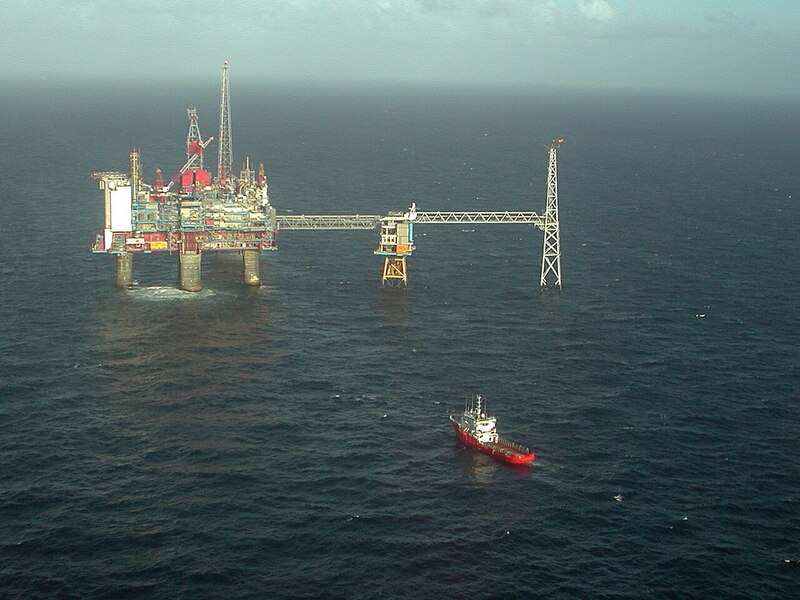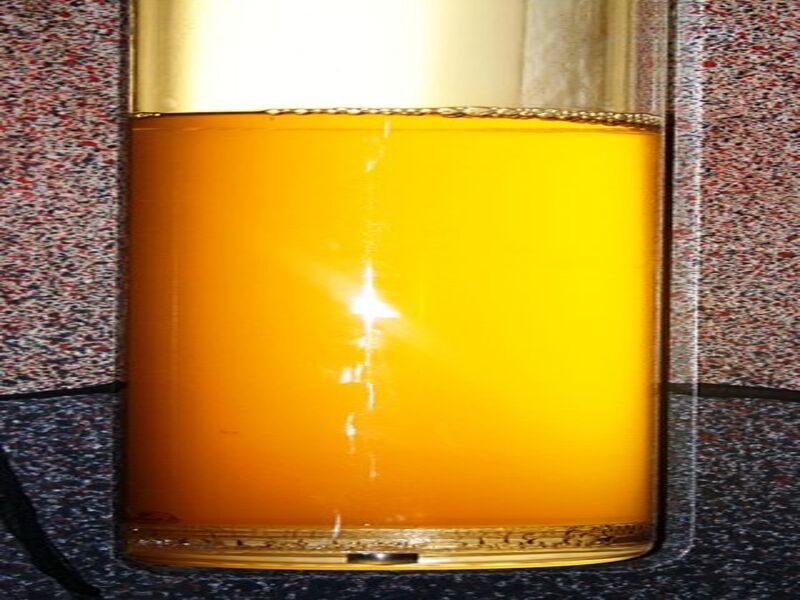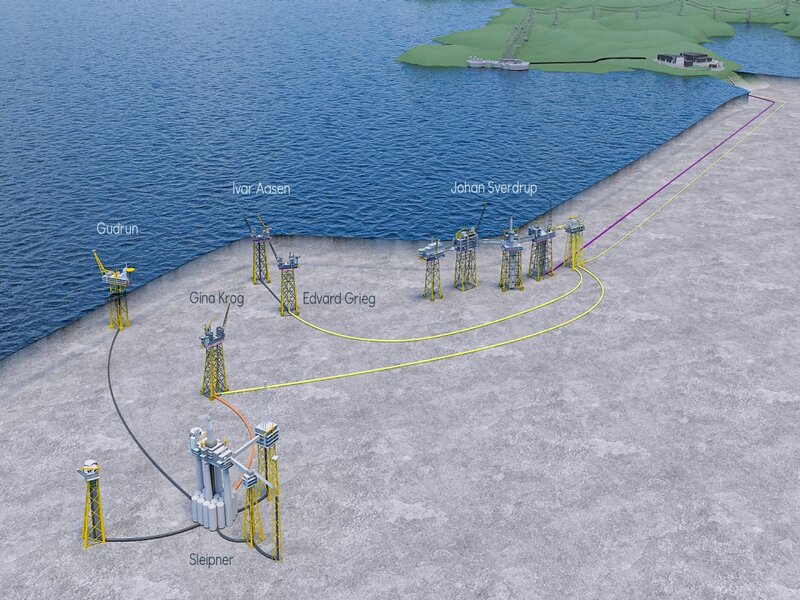The Sleipner Øst Field is an offshore gas and condensate field located in the Central North Sea. Currently, it is in the late tail production phase.
The field was discovered in 1981. The field received the approval for the Plan for Operation and Development (PDO) in 1986. The Sleipner Øst started production in August 1993.
The field is a part of the Sleipner area with Gungne (a satellite field to the Sleipner Øst) and Sleipner Vest gas and condensate fields. The area is operated by Equinor Energy.
The field had original recoverable reserves of 122 million standard cubic meters (Sm3) of oil equivalent of gas and condensate. The current data shows that the field has remaining reserves of 0.3 million standard cubic meters of oil equivalent of gas and condensate.
Project Gallery
In June 2020, Equinor and partners decided to partially electrify the Sleipner Area including the associated fields. The power from the shore will cost around NOK 850 million ($81.49m).
A contribution of up to NOK 430m ($41.22m) from the Business Sector’s NOx Fund will be used for the partial electrification of the area.
The Sleipner Area and associated fields will operate on power from shore from 2024.
The focus of the partners is on increasing reserves and decreasing production decline. The field is expected to produce for the tied-back fields after it has ceased its production.
Sleipner Øst Location Details
The Sleipner Øst Field is located offshore Norway in the central part of the North Sea.
The field lies at a water depth of 80m.
Sleipner Øst Discovery and Reserves
The Sleipner Øst Field was discovered with the drilling of five wells: the wildcat well 15/9-9, two appraisal wells 15/9-11 and 15/9-16, and another wildcat well 15/9-20S.
The wildcat well 15/9-9 (Sleipner Øst discovery) was drilled with the semi-submersible installation Nordraug (now Ocean Winner) on the Sleipner Terrace in the North Sea on 4 May 1981 to a total depth of 3,044m in the Early-Middle Permian Rotliegendes Group.
The objective was to test the presence of hydrocarbons in Jurassic sandstones on the 15/9-Gamma structure and get information about the distribution of sand in the area.
Gas and condensate were proven in the Heimdal formation of the well at 2,322m and residual hydrocarbons were proven over 2,648m to 2,738m on cores from the Triassic Skagerrak Formation.
Three drill stem tests were conducted after the well was abandoned on 14 July 1981 as a gas/condensate discovery.
The appraisal well 15/9-11 was drilled in the south Viking Graben area of the North Sea to appraise the 15/9-9 well, delineate the hydrocarbon accumulation in the Heimdal Formation, and test the presence of hydrocarbons in Triassic sandstones.
The appraisal well was drilled with the semi-submersible installation Ross Rig (1) on 18 September 1981 to a total depth of 2,950m in the Triassic Hegre Group.
Gas and condensate were proven in the Heimdal Formation with a gas-water contact at 2,442m and hydrocarbons were found in the Jurassic Hugin Formation sandstones with a gas-water contact at 2,825m. The Triassic sandstones were devoid of hydrocarbons.
Three drill stem tests were conducted after the well was permanently abandoned on 23 December 1981 as a gas/condensate appraisal well.
Another appraisal well 15/9-16 was drilled on the Sleipner Øst discovery in the southern Viking Graben area of the North Sea to delineate hydrocarbon accumulations in the Heimdal Formation on the gamma structure. The secondary objective was to find hydrocarbons in the Jurassic/Triassic sandstones.
The well was drilled with the semi-submersible installation Deepsea Saga on 28 June 1982 to a total depth of 3,120m into the Permian Rotliegendes Group.
Gas and condensate were discovered in the top Heimdal Formation at 2,378m and weak oil was found between 2,418m and 2,427.5m.
The well was not drill stem tested and was permanently abandoned on 24 August 1982 as a gas/condensate appraisal well.
The wildcat well 15/9-20 S was drilled from the Sleipner A Platform on the field. It was a development well 15/9-A-22 designed to produce gas from the Heimdal reservoir and contribute to the optimal reservoir management in the central North Sea by providing geological and reservoir technical data.
The well was drilled on 16 February 1994 to a total depth of 3,624m in the Triassic Smith Bank Formation.
Gas was found in the 104m thick Heimdal Formation as expected. The well was subjected to two drill stem tests in the Heimdal Formation and was permanently abandoned on 1 June 1994 as a gas discovery.
Sleipner Øst Field Details
The Sleipner Øst Field is developed with Sleipner A Platform. The development included the interconnections between Sleipner A, R, and T platforms.
For development, the Loke Field (a satellite field with gas/condensate) is tied back to Sleipner A Platform. The PDO of Loke Heimdal was approved in 1991 and of Loke Triassic in 1995.
Two subsea templated were installed each for production from the northern part of Sleipner Øst and production from the Loke deposit. A subsea template was connected to Sleipner T to develop Alpha Nord segment in 2004.
The sales gas from the field is exported into the Gassled Transport System (Statpipe, Zeepipe and Europipe II to Emden and Zeebrugge) and the unstable condensate is transported via pipeline to Kårstø in Rogaland for further processing. The condensate is then exported by ship in the market.
Reservoir Details
The reservoirs of the Sleipner Øst and Loke fields lie in the paleocene turbidite sandstone in the Ty Formation, shallow Middle Jurassic marine sandstone in the Hugin Formation, and continental sandstone in the Triassic Skagerrak Formation.
The Skagerrak Formation has poor reservoir quality than Ty and Hugin reservoirs and the Ty Formation has good reservoir quality. The reservoirs lie at a depth of 2,300m.
The Ty Formation reservoir was producing by dry gas recycling until 2005 and stopped producing in 2012. Wells were produced at a reduced inlet pressure to optimise production from the Ty Formation reservoir.
The Hugin Formation reservoir produced by pressure depletion.
Contractors Involved
In January 2024, Kongsberg Digital was awarded a contract by Equinor to rebuild the Sleipner Area’s life cycle simulators using the K-Spice and LedaFlow simulation techniques of Kongsberg. The contract is estimated to be valued at above NOK25m ($2.39m).
Under the contract, three simulators will be developed: an Engineering Study Simulator (ESS), an Engineering Test Simulator (ETS), and an Operator Training Simulator (OTS).
The simulators will model the processes of platforms A, B, and T of the Sleipner Area including all wells, oil pipelines, and offshore production facilities.
The project (Sleipner Life Cycle Simulation Project) will commence in the first quarter of 2024 and is estimated to be completed by the end of 2025.
In October 2019, the Front-End Engineering and Design (FEED) contract to electrify the Sleipner Area was awarded to Aibel which has now been extended to an engineering, procurement, construction, installation and commissioning (EPCIC) contract valued at around NOK400m ($38.29m).
The work for the contract will be conducted at Aibel’s office in Stavanger and Haugesund Yard in October 2019.
The cables for the production and laying for the Sleipner Area will be supplied by NKT in October 2019.
Nordraug was supplied by Diamond Offshore Drilling Ltd and Ross Rig AS P/R owns the drilling facility Ross Rig (1).
The drilling facility Deepsea Pioneer is owned by Hamilton Brothers Oil & Gas.



